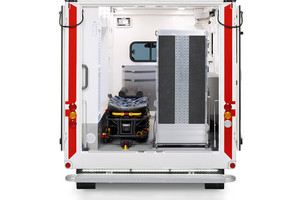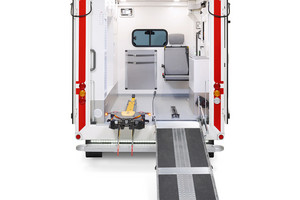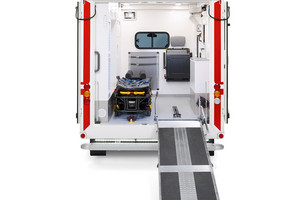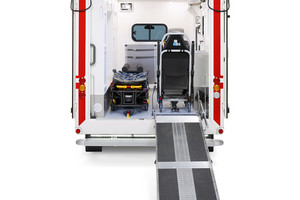The compact ambulances in the Steinfurt district have only been in use since June 2021 but have already covered a distance of over 150,000 km. Not only engine power is needed, however: the vehicles also have to be functional and efficient to cope with the many demands placed on them. For the head of procurement in the district of Steinfurt, Michael Voigt, and his team, two factors were particularly important when it came to the new ambulance vehicles: on the one hand, it should be possible to drive them with a class B (car, max. 3.5 t) driving licence, and on the other, they should offer a particularly high standard of ergonomics for both crew and patients.
For some years now, the district of Steinfurt has been standardising its fleet of vehicles and the associated equipment for all 16 rescue stations. There are currently eight WAS 500 compact box body ambulances in use at seven different rescue stations, with four more to follow soon. The vehicles are mainly used for qualified patient transport (type A2), but can also be used for first responder services if necessary.
Since the advantages of box body vehicles compared to van models had been convincing in the past, the tried and tested criteria of the WAS ambulances with box bodies were also intended to ensure greater comfort and cost-effectiveness in patient transport. By installing an electro-hydraulic stretcher system in combination with an electrically assisted carrying chair, the ergonomic standard was improved without exceeding the 3.5 t weight limit. “This combination would not have been possible in a panel van with the same equipment and weight class – and the crew is pleased with the improved sense of space with more room in which to perform their work. This also makes the ambulance more attractive as a workplace,” says Michael Voigt, explaining the decision for the box body.
Sustainable Box Body Concept.
An additional economic benefit of the current body variant is the possibility of changing the box body. This means that the box body can continue to be used on a new chassis when the base vehicle has reached its maximum service life. “The interest in the interchangeable box body ambulance was sparked several years ago and was repeatedly rekindled during discussions on the expansion of previous ambulance and rescue vehicles. After WAS announced in 2019 that it wanted to offer such a box body change for ambulances, following a detailed cost-benefit analysis, the district of Steinfurt decided to test such a box body exchange on a new base vehicle and call for tenders. Some of our vehicles easily cover more than 100,000 kilometres a year on a 7/24 basis, so it makes sense from an economic and safety point of view to replace the base vehicles after only two years,” says Michael Voigt, describing the decision-making process. The first ambulance box bodies will soon be ready for installation on a new base vehicle.
More information on the box body PTA














No Comments